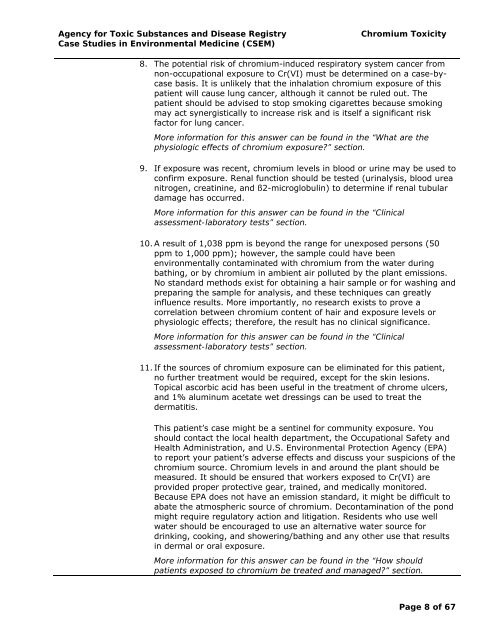(Cr) Toxicity | ATSDR - CSEM - Agency for Toxic Substances and ...
(Cr) Toxicity | ATSDR - CSEM - Agency for Toxic Substances and ...
(Cr) Toxicity | ATSDR - CSEM - Agency for Toxic Substances and ...
Create successful ePaper yourself
Turn your PDF publications into a flip-book with our unique Google optimized e-Paper software.
<strong>Agency</strong> <strong>for</strong> <strong>Toxic</strong> <strong>Substances</strong> <strong>and</strong> Disease Registry Chromium <strong><strong>Toxic</strong>ity</strong><br />
Case Studies in Environmental Medicine (<strong>CSEM</strong>)<br />
8. The potential risk of chromium-induced respiratory system cancer from<br />
non-occupational exposure to <strong>Cr</strong>(VI) must be determined on a case-bycase<br />
basis. It is unlikely that the inhalation chromium exposure of this<br />
patient will cause lung cancer, although it cannot be ruled out. The<br />
patient should be advised to stop smoking cigarettes because smoking<br />
may act synergistically to increase risk <strong>and</strong> is itself a significant risk<br />
factor <strong>for</strong> lung cancer.<br />
More in<strong>for</strong>mation <strong>for</strong> this answer can be found in the “What are the<br />
physiologic effects of chromium exposure?” section.<br />
9. If exposure was recent, chromium levels in blood or urine may be used to<br />
confirm exposure. Renal function should be tested (urinalysis, blood urea<br />
nitrogen, creatinine, <strong>and</strong> ß2-microglobulin) to determine if renal tubular<br />
damage has occurred.<br />
More in<strong>for</strong>mation <strong>for</strong> this answer can be found in the “Clinical<br />
assessment-laboratory tests” section.<br />
10. A result of 1,038 ppm is beyond the range <strong>for</strong> unexposed persons (50<br />
ppm to 1,000 ppm); however, the sample could have been<br />
environmentally contaminated with chromium from the water during<br />
bathing, or by chromium in ambient air polluted by the plant emissions.<br />
No st<strong>and</strong>ard methods exist <strong>for</strong> obtaining a hair sample or <strong>for</strong> washing <strong>and</strong><br />
preparing the sample <strong>for</strong> analysis, <strong>and</strong> these techniques can greatly<br />
influence results. More importantly, no research exists to prove a<br />
correlation between chromium content of hair <strong>and</strong> exposure levels or<br />
physiologic effects; there<strong>for</strong>e, the result has no clinical significance.<br />
More in<strong>for</strong>mation <strong>for</strong> this answer can be found in the “Clinical<br />
assessment-laboratory tests” section.<br />
11. If the sources of chromium exposure can be eliminated <strong>for</strong> this patient,<br />
no further treatment would be required, except <strong>for</strong> the skin lesions.<br />
Topical ascorbic acid has been useful in the treatment of chrome ulcers,<br />
<strong>and</strong> 1% aluminum acetate wet dressings can be used to treat the<br />
dermatitis.<br />
This patient’s case might be a sentinel <strong>for</strong> community exposure. You<br />
should contact the local health department, the Occupational Safety <strong>and</strong><br />
Health Administration, <strong>and</strong> U.S. Environmental Protection <strong>Agency</strong> (EPA)<br />
to report your patient’s adverse effects <strong>and</strong> discuss your suspicions of the<br />
chromium source. Chromium levels in <strong>and</strong> around the plant should be<br />
measured. It should be ensured that workers exposed to <strong>Cr</strong>(VI) are<br />
provided proper protective gear, trained, <strong>and</strong> medically monitored.<br />
Because EPA does not have an emission st<strong>and</strong>ard, it might be difficult to<br />
abate the atmospheric source of chromium. Decontamination of the pond<br />
might require regulatory action <strong>and</strong> litigation. Residents who use well<br />
water should be encouraged to use an alternative water source <strong>for</strong><br />
drinking, cooking, <strong>and</strong> showering/bathing <strong>and</strong> any other use that results<br />
in dermal or oral exposure.<br />
More in<strong>for</strong>mation <strong>for</strong> this answer can be found in the “How should<br />
patients exposed to chromium be treated <strong>and</strong> managed?” section.<br />
Page 8 of 67

















